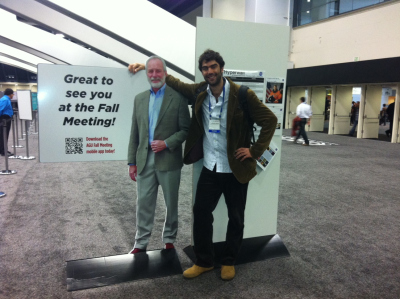Die Inhalte dieser Seite sind leider nicht auf Deutsch verfügbar.
Seitenpfad:
Bremen International Graduate School for Marine Sciences
Ferdinand Oberle
Report of GLOMAR PhD student Ferdinand Oberle about his participation in the American Geophysical Union Fall Meeting, San Francisco, USA, 3 – 7 December 2012
I would like to thank Glomar/MARUM for the financial support to participate in the American Geophysical Union annual fall meeting in San Francisco held from the 3rd - 7th of Dec. 2012.
The AGU offers through its sheer size with a participation of more than 20,000 scientists an impressive display of the scientific affords within the geosciences. On any given day several hundred talks, thousands of posters and multiple workshops are available for listening, viewing and learning. Consequently a careful preparation and in depth study of the conference abstract guide is necessary to allow for the maximum benefit of this event.
While each day was packed with discussions, lectures, workshops and poster viewings some of my highlights of this event were the workshops on teaching geoscience, the presentation and the resulting discussions of my own work and the new insights I gained from several posters on shelfal morphology and their associated sedimentological processes.
The educational workshop gave great insights into the new methodologies used by todays leading geoscience educators in order to be more effective when communicating ones research. Today scientists must go beyond publishing in peer-reviewed journals if they want their research to inform decisions about our future. This workshop covered a much-needed training on how to communicate with the press, the public, and policy makers.
My own research presentation entitled “Volumetric Budget Calculation of Material Storage and Export for a Mid-shelf Mudbelt” focuses on a high resolution source-to-sink deglacial sedimentary budget analysis for NW Galicia that reveals that 34% (+/-10) of all sediments entering the shelf through river input remain in the mudbelt. Furthermore the research has far reaching implications for mudbelt geomorphology and raises questions towards anthropogenic affects on the sediment and carbon cycles. Discussing my results with leading scientists from the field lead to great insights and multiple invitations for further talks and presentations at the USGS and Woods Hole Oceanographic Institute /MIT.
In summary, I feel very fortunate to have been given the opportunity to discuss and present my own work at the AGU Fall meeting in 2012. It gave me the unique opportunity to gain new insights and establish new contacts, which are most valuable not only to the outcome of my PhD but to my scientific career in general.
The AGU offers through its sheer size with a participation of more than 20,000 scientists an impressive display of the scientific affords within the geosciences. On any given day several hundred talks, thousands of posters and multiple workshops are available for listening, viewing and learning. Consequently a careful preparation and in depth study of the conference abstract guide is necessary to allow for the maximum benefit of this event.
While each day was packed with discussions, lectures, workshops and poster viewings some of my highlights of this event were the workshops on teaching geoscience, the presentation and the resulting discussions of my own work and the new insights I gained from several posters on shelfal morphology and their associated sedimentological processes.
The educational workshop gave great insights into the new methodologies used by todays leading geoscience educators in order to be more effective when communicating ones research. Today scientists must go beyond publishing in peer-reviewed journals if they want their research to inform decisions about our future. This workshop covered a much-needed training on how to communicate with the press, the public, and policy makers.
My own research presentation entitled “Volumetric Budget Calculation of Material Storage and Export for a Mid-shelf Mudbelt” focuses on a high resolution source-to-sink deglacial sedimentary budget analysis for NW Galicia that reveals that 34% (+/-10) of all sediments entering the shelf through river input remain in the mudbelt. Furthermore the research has far reaching implications for mudbelt geomorphology and raises questions towards anthropogenic affects on the sediment and carbon cycles. Discussing my results with leading scientists from the field lead to great insights and multiple invitations for further talks and presentations at the USGS and Woods Hole Oceanographic Institute /MIT.
In summary, I feel very fortunate to have been given the opportunity to discuss and present my own work at the AGU Fall meeting in 2012. It gave me the unique opportunity to gain new insights and establish new contacts, which are most valuable not only to the outcome of my PhD but to my scientific career in general.



